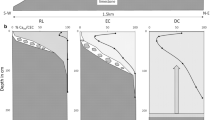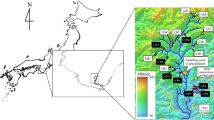Abstract
Elemental ratios of calcium (Ca), strontium (Sr) and barium (Ba) in plant tissue have been used to help identify sources of Ca in trees. However, recent work has clearly shown that ratios of Ca:Sr or Ca:Ba in plant tissues differ from soil values and discrimination factors (alteration of elemental ratios of Ca, Sr and Ba) have been established to account for differences between soil and foliar values. In this study, concentrations of Ca, Sr and Ba (and molar ratios) in bulk deposition, throughfall, soil water and stream water were measured along with tree chemistry and biomass (foliage, branches, bark, wood, roots and litter) at a forested catchment in central Ontario, Canada. Concentrations of Ca, Sr and Ba vary greatly among the eight dominant tree species and plant tissue and molar ratios of Ca:Sr or Ca:Ba vary more than tenfold. In general Ca:Sr ratios were highest in foliage (up to 3,175) and lowest in wood (low as 91) and the mass-weighted Ca:Sr ratio of the total tree biomass was approximately 340. The molar ratio of Ca:Sr in bulk precipitation was ~820, increased to over 1,000 in throughfall and then decreased steadily through the various soil horizons, falling to 320 in the B horizon. Conservative mass balances for the forest floor for Ca, Sr and Ba suggest that more than half the Ca, Sr and Ba annual uptake by trees is obtained from mineral soil, which is consistent with the observation that the weighted-average ratios of Ca:Sr, Ca:Ba or Ba:Sr in the forest biomass fall between values in water draining the forest floor and water draining the rooting zone (B horizon). This work shows that discrimination between Ca, Sr and Ba is primarily internal to trees and discrimination factors between soil and foliage should be interpreted with caution.




Similar content being viewed by others
References
Appelo CAJ, Postma D (1993) Geochemistry, groundwater and pollution. A.A. Balkema, Rotterdam, p 536
Baes AU, Bloom PR (1988) Exchange of alkaline earth cations in soil organic matter. Soil Sci 146:6–14
Blum JD, Klaue A, Nezat CA, Driscoll CT, Johnson CE, Siccama TG, Eagar C, Fahey TJ, Likens GE (2002) Mycorrhizal weathering of apatite as an important calcium source in base poor forest ecosystems. Nature 417:729–731
Blum JD, Dasch AA, Hamburg SP, Yanai RD, Arthur MA (2008) Use of foliar Ca/Sr discrimination and Sr-87/Sr-86 ratios to determine soil Ca sources to sugar maple in a northern hardwood forest. Biogeochem 87:287–296
Blum JD, Hamburg SP, Yanai RD, Arthur MA (2012) Determination of foliar Ca/Sr discrimination factors for six tree species and implications for Ca sources in northern hardwood forests. Plant Soil 356:303–314
Bullen TD, Bailey SW (2005) Identifying calcium sources at an acid deposition-impacted spruce forest: a strontium isotope, alkaline-earth element multi-tracer approach. Biogeochem 74:63–99
Clarkson DT (1984) Calcium transport between tissues and its distribution in the plant. Plant Cell Environ 7:449–456
Dasch A, Blum JD, Eagar C, Fahey TJ, Driscoll CT, Siccama TG (2006) The relative uptake Ca and Sr into tree foliage using a whole-watershed calcium addition. Biogeochem 80:21–41
Dillon PJ, Lazerte BD (1992) Response of the plastic lake catchment, Ontario, to reduced sulfur deposition. Environ Pollut 77(2–3):211–217
Dillon PJ, Jeffries DS, Scheider WA (1982) The use of calibrated lakes and watersheds for estimating atmospheric deposition near a large point source. Water Air Soil Pollut 18:241–258
Drouet T, Herbauts J (2008) Evaluation of the mobility and discrimination of Ca, Sr and Ba in forest ecosystems: consequence of the use of alkaline-earth element ratios as tracers of Ca. Plant Soil 302:105–124
Environment Canada (2013) Canada climate archive. http://climate.weather.gc.ca
Federer CA, Hornbeck JW, Tritton LM, Martin CW, Pierce RS, Smith CT (1989) Long-term depletion of calcium and other nutrients in eastern US forests. Environ Manage 13:593–601
Gierth M, Stelzer R, Lehmann H (1998) Endodermal Ca and Sr partitioning in needles of the European larch (Larix decidua (L.) Mill.). J Plant Physiol 152(1):25–30
Gulpin M, Turk S, Fink S (1995) Ca nutrition in conifers. Z Pflanzenernahr Bodenk 158:519–527
Hamburg SP, Yanai RD, Arthur MA, Blum JD, Siccama TG (2003) Biotic control of calcium cycling in northern hardwood forests: acid rain and aging forests. Ecosystems 6:399–406
Hawley GJ, Schaberg PG, Eager C, Borer CH (2006) Calcium addition at the Hubbard Brook experimental forest reduced winter injury to red spruce in a high-injury year. Can J For Res 36(10):2544–2549
Horsley SB, Long RP, Bailey SW, Hallett RA, Hall TJ (2000) Factors associated with the decline disease of sugar maple on the Allegheny plateau. Can J For Res 30:1365–1378
IUSS Working Group WRB (2007) World Reference Base for Soil Resources 2006, first update 2007. World Soil Resources Reports No. 103. FAO, Rome
Johnson CE, Johnson AH, Siccama TG (1992) Whole-tree clear–cutting effects on exchangeable cations and soil acidity. Soil Sci Soc Amer J 55:502–508
Lapenis AG, Lawrence GB, Andreev AA, Bobrov AA, Torn MS, Harden JW (2004) Acidification of forest soil in Russia: from 1893 to present. Glob Biogeochem Cycles. doi:10.1029/2003GB002107
Lawrence GB, David MB, Bailey SW, Shortle WC (1997) Assessment of soil calcium status in red spruce forests in the north-eastern United States. Biogeochem 38:19–39
Likens GE, Driscoll CT, Buso DC (1996) Long-term effects of acid rain: response and recovery of a forest ecosystem. Science 272:244–246
Likens GE, Driscoll CT, Buso DC, Siccama TG, Johnson CE, Lovett GM, Fahey TJ, Reiners WA, Ryan DF, Martin CW, Bailey SW (1998) The biogeochemistry of calcium at Hubbard Brook. Biogeochem 41:89–173
Lozano F (1987) Physical and chemical properties of the soils at the southern biogeochemistry study site Report BGC-018. Dorset Research Centre, Ontario Ministry of the Environment, Dorset (Ont.)
Miller EK, Blum JD, Friedland AJ (1993) Determination of soil exchangeable-cation loss and weathering rates using Sr isotopes. Nature 362:438–441
Momoshima N, Bondietti EA (1990) Cation binding in wood: applications to understanding historical changes in divalent cation availability to red spruce. Can J For Res 20:1840–1849
Neary AJ, Gizyn WI (1994) Throughfall and stemflow chemistry under deciduous and coniferous forest canopies in South-Central Ontario. Can J For Res 24:1089–1100
Poszwa A, Dambrine E, Pollier B, Atteia O (2000) A comparison between Ca and Sr cycling in forest ecosystems. Plant Soil 225:299–310
Runia LT (1987) Strontium and calcium distribution in plants: effects on palaeodietary studies. J Archaeol Sci 14(6):599–608
Schaberg PG, DeHayes DH, Hawley GJ (2001) Anthropogenic calcium depletion: a unique threat to forest ecosystem health? Ecosys Health 7:214–228
Scheider WA, Cox CM, Scott LD (1983) Hydrological data for lakes and watersheds in the Muskoka-Haliburton study area (1976–1980). Ontario Ministry of Environment Data Report 83/6
Skeldon M, Vadeboncoeur MA, Hamburg SP, Blum JD (2007) Terrestrial gastropod distribution in the northern hardwood forest: the role of calcium and forest composition. Can J Zool 85:994–1007
Soil Classification Working Group (1998) The Canadian System of Soil Classification Publ. 1646 (Revised):187
Tamm CO, Hallbacken L (1986) Changes in soil pH over a 50-year period under different forest canopies, in SW Sweden. Water Air Soil Pollut 31:337–341
Thimonier A, Dupouey JL, Tacon FL (2000) Recent losses of base cations from soils of Fagus sylvatica L. stands in northeastern France. Ambio 29:314–321
Watmough SA, Aherne J (2008) Estimating calcium weathering rates and future lake calcium concentrations in the Muskoka-Haliburton region of Ontario. Can J Fish Aquat Sci 65:821–833
Watmough SA, Dillon PJ (2003) Mycorrhizal weathering in base-poor forests. Nature 423:823–824
Watmough SA, Dillon PJ (2004) Major element fluxes from a coniferous catchment in central Ontario, 1983–1999. Biogeochem 67:369–398
Watmough SA, Aherne J, Alewell C, Arp P, Bailey S, Clair T, Dillon PJ, Duchesne L, Eimers MC, Fernandez I, Foster N, Larseen T, Miller E, Mitchell MJ, Page S (2005a) Sulphate, nitrogen and base cation budgets at 21 forested catchments in Canada, the United States and Europe. Environ Monitor Assess 109:1–36
Watmough SA, Dillon PJ, Epova EN (2005b) Metal partitioning and uptake in central Ontario forests. Environ Pollut 134:493–502
Acknowledgments
This work was funded through by the Canadian Water Network and the Natural Sciences and Engineering Council of Canada (NSERC). The author gratefully acknowledges the help from staff at the Ontario Ministry of Environment Dorset Environmental Centre and various Trent students who helped with data collection and analysis.
Author information
Authors and Affiliations
Corresponding author
Additional information
Responsible Editor: E. Veldkamp.
Rights and permissions
About this article
Cite this article
Watmough, S.A. Calcium, strontium and barium biogeochemistry in a forested catchment and insight into elemental discrimination. Biogeochemistry 118, 357–369 (2014). https://doi.org/10.1007/s10533-013-9938-x
Received:
Accepted:
Published:
Issue Date:
DOI: https://doi.org/10.1007/s10533-013-9938-x




